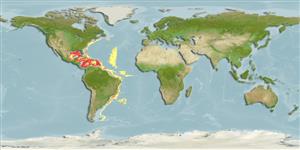>
Beryciformes (Sawbellies) >
Stephanoberycidae (Pricklefishes)
Etymology: Stephanoberyx: Greek, stephanos = crown + Greek, beryx or berys = a name of a fish, in reference to Berycidae with thin osseus ridges on the head.
Eponymy: No etymology is given in the original description, but apparently named after the author’s niece, Mona. (Ref. 128868), visit book page.
More on author: Gill.
Environment: milieu / climate zone / depth range / distribution range
Ökologie
seewasser bathydemersal; tiefenbereich 945 - 4777 m (Ref. 51654). Deep-water
Western Atlantic: New England, USA to the Gulf of Mexico, Caribbean Sea, and the Lesser Antilles.
Length at first maturity / Size / Gewicht / Alter
Maturity: Lm ?, range 8 - ? cm
Max length : 8.1 cm Männchen/unbestimmt; (Ref. 37108)
Rückenflossenstacheln (insgesamt) : 1; Rückenflossenweichstrahlen (insgesamt) : 3. Snout not protruding beyond premaxillary symphysis (Ref. 37108).
Adults probably abyssal benthic (Ref. 51654).
Life cycle and mating behavior
Geschlechtsreife | Fortpflanzung | Ablaichen | Eier | Fecundity | Larven
Ebeling, A.W. and W.H. Weed, 1973. Order Xenoberyces (Stephanoberyciformes). In: Fishes of the Western North Atlantic. Mem. Sears Found. Mar. Res. (MSFMR), Mem. 1 (pt 6):397-478. (Ref. 31275)
IUCN Rote Liste Status (Ref. 130435: Version 2024-1)
Bedrohung für Menschen
Harmless
Nutzung durch Menschen
Tools
Zusatzinformationen
Download XML
Internet Quellen
Estimates based on models
Preferred temperature (Ref.
123201): 3.2 - 4.3, mean 4.1 °C (based on 404 cells).
Phylogenetic diversity index (Ref.
82804): PD
50 = 1.0625 [Uniqueness, from 0.5 = low to 2.0 = high].
Bayesian length-weight: a=0.01122 (0.00514 - 0.02450), b=3.04 (2.87 - 3.21), in cm total length, based on all LWR estimates for this body shape (Ref.
93245).
Trophic level (Ref.
69278): 3.3 ±0.5 se; based on size and trophs of closest relatives
Widerstandsfähigkeit (Ref.
120179): mittel, Verdopplung der Population dauert 1,4 - 4,4 Jahre. (Preliminary K or Fecundity.).
Fishing Vulnerability (Ref.
59153): Low vulnerability (10 of 100).
